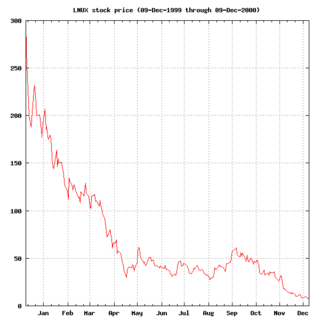
Fundamental analysis, in accounting and finance, is the analysis of a business's financial statements ; health; and competitors and markets. It also considers the overall state of the economy and factors including interest rates, production, earnings, employment, GDP, housing, manufacturing and management. There are two basic approaches that can be used: bottom up analysis and top down analysis. These terms are used to distinguish such analysis from other types of investment analysis, such as quantitative and technical.
Real options valuation, also often termed real options analysis, applies option valuation techniques to capital budgeting decisions. A real option itself, is the right—but not the obligation—to undertake certain business initiatives, such as deferring, abandoning, expanding, staging, or contracting a capital investment project. For example, the opportunity to invest in the expansion of a firm's factory, or alternatively to sell the factory, is a real call or put option, respectively.
A quantitative analyst is a person who specializes in the application of mathematical and statistical methods to financial and risk management problems. The occupation is similar to those in industrial mathematics in other industries.
In finance, volatility clustering refers to the observation, first noted as Mandelbrot (1963), that "large changes tend to be followed by large changes, of either sign, and small changes tend to be followed by small changes." A quantitative manifestation of this fact is that, while returns themselves are uncorrelated, absolute returns or their squares display a positive, significant and slowly decaying autocorrelation function: corr(|rt|, |rt+τ |) > 0 for τ ranging from a few minutes to several weeks. This empirical property has been documented in the 90's by Granger and Ding (1993) and Ding and Granger (1996) among others; see also. Some studies point further to long-range dependence in volatility time series, see Ding, Granger and Engle (1993) and Barndorff-Nielsen and Shephard.
In financial economics, asset pricing refers to a formal treatment and development of two main pricing principles, outlined below, together with the resultant models. There have been many models developed for different situations, but correspondingly, these stem from general equilibrium asset pricing or rational asset pricing, the latter corresponding to risk neutral pricing.
Financial modeling is the task of building an abstract representation of a real world financial situation. This is a mathematical model designed to represent the performance of a financial asset or portfolio of a business, project, or any other investment.
Kenneth Jan Singleton is an American economist. He is a leading figure in empirical financial economics, and a faculty member at Stanford University.

Lars Peter Hansen is an American economist. He is the David Rockefeller Distinguished Service Professor of economics at the University of Chicago and a 2013 recipient of the Nobel Memorial Prize in Economics.
The following outline is provided as an overview of and topical guide to finance:
Statistical finance, is the application of econophysics to financial markets. Instead of the normative roots of much of the field of finance, it uses a positivist framework including exemplars from statistical physics with an emphasis on emergent or collective properties of financial markets. The starting point for this approach to understanding financial markets are the empirically observed stylized facts.

In finance, an option is a contract which gives the buyer the right, but not the obligation, to buy or sell an underlying asset or instrument at a specified strike price prior to or on a specified date, depending on the form of the option. The strike price may be set by reference to the spot price of the underlying security or commodity on the day an option is taken out, or it may be fixed at a discount or at a premium. The seller has the corresponding obligation to fulfill the transaction – to sell or buy – if the buyer (owner) "exercises" the option. An option that conveys to the owner the right to buy at a specific price is referred to as a call; an option that conveys the right of the owner to sell at a specific price is referred to as a put. Both are commonly traded, but the call option is more frequently discussed.
A master's degree in Financial Economics provides a rigorous understanding of theoretical finance and the economic framework upon which that theory is based. The degree is postgraduate, and usually incorporates a thesis or research component. Programs may be offered jointly by the business school and the economics department.
Mathematical finance, also known as quantitative finance and financial mathematics, is a field of applied mathematics, concerned with mathematical modeling of financial markets. Generally, mathematical finance will derive and extend the mathematical or numerical models without necessarily establishing a link to financial theory, taking observed market prices as input. Mathematical consistency is required, not compatibility with economic theory. Thus, for example, while a financial economist might study the structural reasons why a company may have a certain share price, a financial mathematician may take the share price as a given, and attempt to use stochastic calculus to obtain the corresponding value of derivatives of the stock. The fundamental theorem of arbitrage-free pricing is one of the key theorems in mathematical finance, while the Black–Scholes equation and formula are amongst the key results.
Campbell Russell "Cam" Harvey is a Canadian economist, known for his work on asset allocation with changing risk and risk premiums and the problem of separating luck from skill in investment management. He is currently the J. Paul Sticht Professor of International Business at Duke University's Fuqua School of Business in Durham, North Carolina, as well as a research associate with the National Bureau of Economic Research in Cambridge, Massachusetts. He is also a research associate with the Institute of International Integration Studies at Trinity College in Dublin and a visiting researcher at University of Oxford. He served as the 2016 president of the American Finance Association.
Stephen John Taylor is a semi-retired British Professor of Finance at Lancaster University Management School, an authority on stochastic volatility models and option prices, a researcher in the areas of financial econometrics and mathematical finance, and an author who has published academic books and influential learned papers in Mathematical Finance, the Journal of Financial and Quantitative Analysis, the Journal of Econometrics and several other academic journals
Francis X. Diebold is an American economist known for his work in predictive econometric modeling, financial econometrics, and macroeconometrics. He earned both his B.S. and Ph.D. degrees at the University of Pennsylvania ("Penn"), where his doctoral committee included Marc Nerlove, Lawrence Klein, and Peter Pauly. He has spent most of his career at Penn, where he has mentored approximately 75 Ph.D. students. Presently he is Paul F. and Warren S. Miller Professor of Social Sciences and Professor of Economics at Penn’s School of Arts and Sciences, and Professor of Finance and Professor of Statistics at Penn’s Wharton School. He is also a Faculty Research Associate at the National Bureau of Economic Research in Cambridge, Massachusetts, and author of the No Hesitations blog.
High frequency data refers to time-series data collected at an extremely fine scale. As a result of advanced computational power in recent decades, high frequency data can be accurately collected at an efficient rate for analysis. Largely used in financial analysis and in high frequency trading, high frequency data provides intraday observations that can be used to understand market behaviors, dynamics, and micro-structures.





